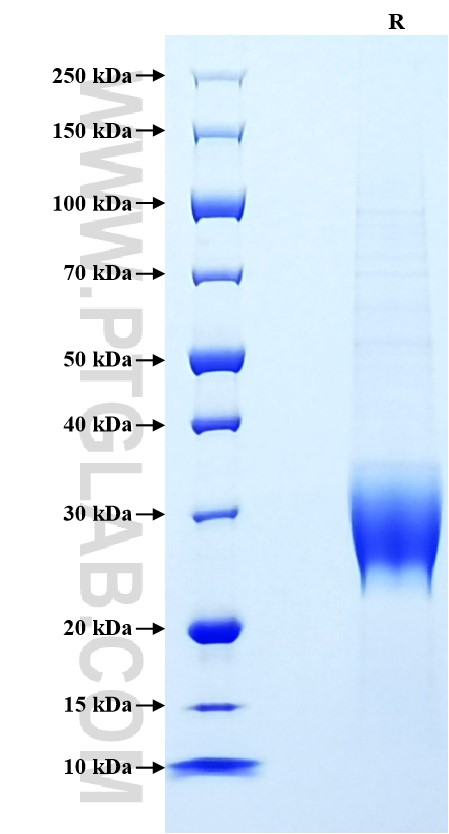Recombinant Mouse G-CSF protein (His Tag)
种属
Mouse
纯度
>90 %, SDS-PAGE
标签
His Tag
生物活性
未测试
验证数据展示
产品信息
| 纯度 | >90 %, SDS-PAGE |
| 内毒素 | <0.1 EU/μg protein, LAL method |
| 生物活性 |
Not tested |
| 来源 | HEK293-derived Mouse G-CSF protein Val31-Ala208 (Accession# P09920) with a His tag at the C-terminus. |
| 基因ID | 12985 |
| 蛋白编号 | P09920 |
| 预测分子量 | 22.8 kDa |
| SDS-PAGE | 24-32 kDa, reducing (R) conditions |
| 组分 | Lyophilized from 0.22 μm filtered solution in PBS, pH 7.4. Normally 5% trehalose and 5% mannitol are added as protectants before lyophilization. |
| 复溶 | Briefly centrifuge the tube before opening. Reconstitute at 0.1-0.5 mg/mL in sterile water. |
| 储存条件 |
It is recommended that the protein be aliquoted for optimal storage. Avoid repeated freeze-thaw cycles.
|
| 运输条件 | The product is shipped at ambient temperature. Upon receipt, store it immediately at the recommended temperature. |
背景信息
Granulocyte colony-stimulating factor (G-CSF), also referred to as CSF3, is a protective cytokine with anti-inflammatory effects. G-CSF is important in promoting survival of the granulocytic lineage cells and proliferation and migration of neutrophils as well as trophoblast cells. G-CSF acts by binding to its receptor G-CSFR (also called CSF3R), which after binding with G-CSF activates the canonical Janus kinase (Jak)/signal transducer, activator of transcription (STAT) and Ras/Raf/MAP kinase pathways. G-CSF potently stimulates the proliferation and release of peripheral blood progenitor cells into the bloodstream and is therefore used to treat neutropenia after chemotherapy. Furthermore, G-CSF levels are elevated upon intensive exercise leading to increased neutrophil counts, which are predominantly due to delayed neutrophil apoptosis.
参考文献:
1. Panopoulos AD. et al. (2008). Cytokine. 42(3):277-88. 2. Zhao SQ. et al. (2015). Zhongguo Shi Yan Xue Ye Xue Za Zhi. 23(3):871-7. 3. Sheridan WP. et al.(1989). Lancet. 2(8668):891-5. 4. Sheridan WP. et al.(1992). 339(8794):640-4. 5. Yamada M. et al. (2002). 92(5):1789-94. 6. Mooren FC. Et. Al.(2012). 113(7):1082-90.
